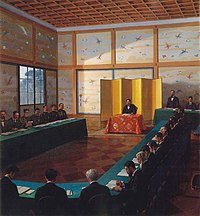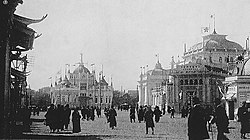Hojo Modernisation: Difference between revisions
(Created page with "{{WIP}} '''Hojo Modernisation''' (補助近代化, ''Hojo Kindaika''), sometimes referred to as the Honourable Revival (名誉ある復活, ''Meiyo Aru Fukkatsu''), was a tran...") |
No edit summary |
||
| Line 1: | Line 1: | ||
{{WIP}} | {{WIP}} | ||
[[File:Black and white photo of emperor Meiji of Japan.jpg|thumb|right|180px|Emperor Hojo.]] | |||
'''Hojo Modernisation''' (補助近代化, ''Hojo Kindaika''), sometimes referred to as the Honourable Revival (名誉ある復活, ''Meiyo Aru Fukkatsu''), was a transition period in Hoterallia that transformed Hoterallia from a dominant agrarian country into an industrialised empire. Hoterallia was one of the pioneers in industrialisation and modernisation as they heavily focused on the development of machine tools and the mechanized factory system. | '''Hojo Modernisation''' (補助近代化, ''Hojo Kindaika''), sometimes referred to as the Honourable Revival (名誉ある復活, ''Meiyo Aru Fukkatsu''), was a transition period in Hoterallia that transformed Hoterallia from a dominant agrarian country into an industrialised empire. Hoterallia was one of the pioneers in industrialisation and modernisation as they heavily focused on the development of machine tools and the mechanized factory system. | ||
| Line 8: | Line 9: | ||
==Establishment of The National Diet and Constitution== | ==Establishment of The National Diet and Constitution== | ||
In 1802, Emperor Hojo organised a meeting with his royal cabinet to discuss the creation of a constitution, as well as another government to help run Hoterallia with him. After a 5 days discussion, Hojo and the royal cabinet settled on a proper constitution draft, this draft followed the constitution of the Vultesian Empire at the time | [[File:Conference on Drafting a Constitution by Goseda Horyu (Meiji Memorial Picture Gallery).jpg|left|thumb|200px|The Conference of Drafting the Constitution.]] | ||
In 1802, Emperor Hojo organised a meeting with his royal cabinet to discuss the creation of a constitution, as well as another government to help run Hoterallia with him. After a 5 days discussion, Hojo and the royal cabinet settled on a proper constitution draft, this draft followed the constitution of the [[Vultesia|Vultesian Empire]] at the time, they followed their basic structure with modifications to suits Hoterallia as well as Hoterallian characteristics. | |||
Ita Kaida, a royal cabinet member, was appointed to research the constitution of Anteria and was also appointed to write the drafts. Many drafts were written, mostly by him with some assistance from the Emperor and the royal cabinet. | Ita Kaida, a royal cabinet member, was appointed to research the constitution of Anteria and was also appointed to write the drafts. Many drafts were written, mostly by him with some assistance from the Emperor and the royal cabinet. | ||
| Line 23: | Line 25: | ||
Some leaders went out to foreign lands and used the knowledge and government writings to help shape and form a more influential government within their walls that allowed for things such as production and infrastructure. Not only that, Hoterallia was rich in resources at the time, this also helped them in terms of production. | Some leaders went out to foreign lands and used the knowledge and government writings to help shape and form a more influential government within their walls that allowed for things such as production and infrastructure. Not only that, Hoterallia was rich in resources at the time, this also helped them in terms of production. | ||
[[File:Tokyo Industrial Exhibition.JPG|thumb|right|250px|1867 Oracloer Industrial Exhibition.]] | |||
The rapid industrialization and modernization of Hoterallia both allowed and required a massive increase in production and infrastructure. Hoterallia built industries such as shipyards, iron smelters, and spinning mills, which were then sold to well-connected entrepreneurs. Consequently, domestic companies became consumers of international technology and applied it to produce items that would be sold cheaply in the international market. With this, industrial zones grew enormously, and there was a massive migration to industrializing centres from the countryside. | The rapid industrialization and modernization of Hoterallia both allowed and required a massive increase in production and infrastructure. Hoterallia built industries such as shipyards, iron smelters, and spinning mills, which were then sold to well-connected entrepreneurs. Consequently, domestic companies became consumers of international technology and applied it to produce items that would be sold cheaply in the international market. With this, industrial zones grew enormously, and there was a massive migration to industrializing centres from the countryside. | ||
[[Category:Hoterallia]] | [[Category:Hoterallia]] | ||
Revision as of 14:26, 19 August 2021
This article is incomplete because it is pending further input from participants, or it is a work-in-progress by one author. Please comment on this article's talk page to share your input, comments and questions. Note: To contribute to this article, you may need to seek help from the author(s) of this page. |
Hojo Modernisation (補助近代化, Hojo Kindaika), sometimes referred to as the Honourable Revival (名誉ある復活, Meiyo Aru Fukkatsu), was a transition period in Hoterallia that transformed Hoterallia from a dominant agrarian country into an industrialised empire. Hoterallia was one of the pioneers in industrialisation and modernisation as they heavily focused on the development of machine tools and the mechanized factory system.
Coronation of Emperor Hojo
After the death of Emperor Nuko, his son, Hideko Shiro was crowned as the next Emperor of Hoterallia. He was one of the most controversial princes as he views Hoterallia as running behind some countries in Anteria, he sought to make Hoterallia one of the most industrialised countries in the south.
As he ascended to the Phoenix Throne on September 1, 1798, he slowly asserted his power over both the royal cabinet, as well as the government and the military. This time also saw Hoterallia change from being a feudal, agrarian society to having a market economy and left the Hoterallian with a lingering influence of modernity and industrialisation.
Establishment of The National Diet and Constitution
In 1802, Emperor Hojo organised a meeting with his royal cabinet to discuss the creation of a constitution, as well as another government to help run Hoterallia with him. After a 5 days discussion, Hojo and the royal cabinet settled on a proper constitution draft, this draft followed the constitution of the Vultesian Empire at the time, they followed their basic structure with modifications to suits Hoterallia as well as Hoterallian characteristics.
Ita Kaida, a royal cabinet member, was appointed to research the constitution of Anteria and was also appointed to write the drafts. Many drafts were written, mostly by him with some assistance from the Emperor and the royal cabinet.
Most of the outside constitution failed to capture Hoterallian ethics as well as morality, Ita had to reject some notions, even from Vultesia. To fix this, he, therefore, added references to the Kokuseki Kisoku or "Nationality Rules" as the justification of the emperor's authority through his divine descent and the unbroken line of emperors, and the unique relationship between subject and sovereign.
Military reforms
TBA
Centralisation
Industrial growth
Hoterallia was already a powerful country in the south, both militarily and economically, this helped Hoterallia effort to industrialised. Economics and the market both influenced how the people used the market as a place of growth. The Empire of Hoterallia had gone under a mass transformation that helped them economically.
But the Empire suffered a downside during this period, Hoterallia had yet to improve much of their navy and merchants fleet, this severely downgraded their economic outputs, to counter this, Hoterallia had to rely on foreign merchants to both import and export their material and production.
Some leaders went out to foreign lands and used the knowledge and government writings to help shape and form a more influential government within their walls that allowed for things such as production and infrastructure. Not only that, Hoterallia was rich in resources at the time, this also helped them in terms of production.
The rapid industrialization and modernization of Hoterallia both allowed and required a massive increase in production and infrastructure. Hoterallia built industries such as shipyards, iron smelters, and spinning mills, which were then sold to well-connected entrepreneurs. Consequently, domestic companies became consumers of international technology and applied it to produce items that would be sold cheaply in the international market. With this, industrial zones grew enormously, and there was a massive migration to industrializing centres from the countryside.


